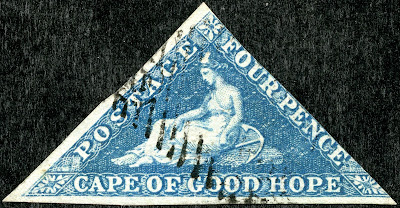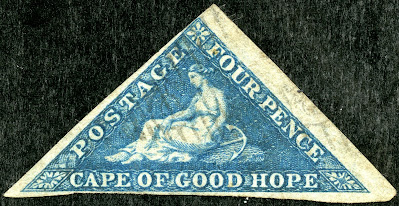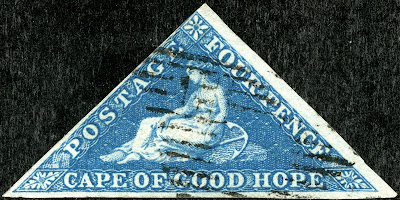I have some 40 Cape of Good Hope 1853-64 Triangular Four Pence Blues, and perhaps a third of them show some degree of sulfuretting. Yes- a lot. !! These ugly gray-greenish- brown spots can change the perceived color of the stamp.
I touched on the problem with this post...
..where two stamps (Ex 8 & 9) showed evidence of sulfuretting. I also gave an explanation and details of my understanding of sulfuretting.
As I would prefer, with this blog post, to just do a "show & tell" of some of the sulfuretted stamps in my collection, I will put the chemical explanation of "sulfuretting" at the end of this blog post, if the reader wishes to read it. (The explanations are still speculative, as I have found suggestive, but not definitive literature on the subject.)
One can see the sulfuretting discoloration most clearly by the feet of "Hope Seated", but there are other areas also. Would 3% Peroxide treatment work for this stamp to restore the original color? Most collectors are aware that orange or yellow stamps can show a degradation to brown due to sulfuretting. But it turns out the COGH 4d blue stamps with brown sulfuretted spots also can be treated!
Generally, it removes micro-debris and gum debris. (Caution: Immerse in Peroxide only on "used" stamps where one doesn't care about gum remnants. Don't immerse an "unused" stamp with intact gum - you will lose the gum.)
And it can cause apparent "whitening" of the paper. (Recall that Peroxide can be a bleaching agent. This may be a function of how long the stamp is immersed in the Peroxide.)
Actually, in my opinion, most of the "whitening" is because of removal of yellow gum debris.
Still, I am quite conservative, and only immerse the stamp in Peroxide for 60 seconds, followed by a water bath, and then overnight drying and flattening in a stamp drying book.
Example 3
1855 SG 6a (Sc4 or 4e?) 4d blue / white paper (over-inked)
Upper: Sulfuretted; Lower: Treated
This stamp has some sulfuretting near the foot of "Hope Seated". This is cleared up with Peroxide treatment.
Now to my eyes, this stamp is more "blue" than "deep blue" after treatment. Perhaps this is a SG 6a 4d blue/ white paper? This interesting blue color, Scott wise, could be a Scott 4 4d blue/white paper, or possibly a Scott 4e "bright blue"?
Note the "engine-turned -background" around "Hope Seated" has little detail on this Perkins Bacon printed stamp? The term "wooly" is sometimes used for this condition, especially with De La Rue printed stamps. For the DLR stamps, it is thought that the DLR prepared paper and the DLR ink did not adhere well together, leaving pools and flakes of ink.
With the Perkins Bacon stamps (such as this one), the "wooly" feature is thought to be from over-inking - a different cause.
And, although most stamps that are sulfuretted are a "deep blue" color, this stamp is sulfuretted AND appears "blue" after treatment. Of interest, the sulfuretting is occurring on an over-inked "blue" stamp. Possible cause?
Example 4
1855 SG 6 (Sc 4b) 4d deep blue/white paper
Upper: Sulfuretted; Lower: Treated
This specimen also shows sulfuretting by the foot of "Hope Seated, but other areas as well. The stamp is definitely improved with treatment.
Example 5
1855 SG 6 (Sc 4b) deep blue/ white paper (over-inked)
Upper: Sulfuretted; Lower: Treated
This stamp is not the best (diagonal crease, large obliterator cancel), but I show it to see if the reader can spot the sulfuretting.
Also the stamp has lack of detail in the engine-turned- background. But the color is wrong for a DLR issue (not an indigo color), so this is an over-inked PB specimen.
I should mention that I have not seen an example of a 4d blue DLR stamp that is sulfuretted. Perhaps the paper-ink DLR process has prevented that from occurring?
Note: The sulfuretting is found above "OD HO" of "GOOD HOPE".
Example 6
1855 SG 6 (Sc 4b) deep blue /white paper (a sharp specimen)
Upper: Sulfuretted; Lower: Treated
This is an interesting stamp. To my eyes, this stamp's color, although I labeled it "deep blue", does have some "blue" qualities after treatment.
But most stamps that are found sulfuretted are "deep blue"*, and this stamp is clearly sulfuretted (most obvious between "Hope" and "OUR" of "FOUR).
*I'm actually beginning to wonder if the sulfuretting, which causes the stamp to assume a darker hue (perceived color), is the reason that conventional wisdom states that "deep blue" stamps are more susceptible to sulfuretting? Because, after treatment, and apparent restoration to the original color, the stamp doesn't really look "deep blue" anymore, but often more "blue".
Note the "engine-turned-background" is "sharp": the boomerang markings and dots are quite evident.
Example 7
1855 SG 6 (Sc 4b) 4d deep blue/ white paper (quite sharp)
Upper: Sulfuretted; Lower: Treated
Can you find the sulfuretting? I show this stamp because sometimes the cancel markings can be confused with sulfuretting.
I think there is a patch between "Hope" and "R" of "FOUR".
I'm finding little reason to not use Peroxide treatment if one is suspicious of sulfuretting. It also helps to remove 160 years of debris and grime from the stamp. Still, it does go against my general approach of "leave well enough alone". 😎
Example 8
1855-58 SG6a (Sc 4 or 4e? ) 4d blue/ white paper (over-inked)
Upper: Sulfuretted; Lower: Treated
The sulfuretting is extensive: major areas include around the feet of "Hope", and below "TAGE" of "POSTAGE". The areas are improved nicely with treatment, but leave a "blue" stamp that is over-inked (little detail in the engine-turned-background).
Most of my stamps that are sulfuretted are "deep blue". But this is now the 2nd stamp I have found which is "blue" to my eyes after treatment, sulfuretted, AND over-inked. It may be that PB 4d stamps that are over-inked are more susceptible to sulfuretting?
Also, note the large perceived color difference in the stamp before and after treatment? I think that drives home the lesson that color of a stamp that is sulfuretted should not be assigned until the sulfuretting is removed.
Example 9
1855-58 SG6 (Sc 4b) 4d deep blue/white paper (over-inked)
Upper: Sulfuretted; Lower: Treated (Here for 10 minutes)
Now this stamp is interesting, and not in a good way. Note the essentially green color along the "Four pence" edge? Could this be a color changeling (due to exposure to chemicals), or perhaps an especially egregious form of sulfuretting?
OK, I treated with Peroxide for 60 seconds. A 60 second immersion was not cutting it, so I extended the immersion to ten minutes.
And the result was.....No change.!! There was not one bit of difference.
I think we can safely say the stamp was subject to some sort of chemical change, not sulfuretting. (From my chemistry study days, when I see green, I think of copper compounds.)
Example 10 Reverse
Reverse Side: 1853 SG 4 (Sc 2) 4d deep blue/ slightly blued paper
Upper: Sulfuretted; Lower: Treated
OK, this stamp gives us a bit of mystery (primarily on the reverse). What is the brown discoloration? Is it sulfuretting or something else?
The stamp itself was identified as a 1853 SG 4 (Sc 2) 4d deep blue / slightly blued paper specimen. (One could perhaps argue that the paper bluing is extensive enough to call this a 1853 SG 2 (Sc 2a) 4d deep blue / deeply blued paper.)
One has to be very cautious here, because there is a risk that the Peroxide treatment COULD diminish the paper bluing. After all, the reason Perkins Bacon added paper bluing was to make the ink
"singly fugitive" to organic solvents. If I can quote Chris Dorn of The Stamp Forum: "It means that if one attempts to remove a cancellation by means of a solvent, that the ink will be affected in such a way as to show that the stamp has been tampered with".
Certainly Benzene, as a solvent, might cause damage. But what about 3% H2O2 (97% H2O)?
Right or wrong, I went ahead with the Peroxide treatment.
And success! The browning completely went away, leaving intact paper bluing, which appears to be not diminished in intensity. Yes!!!!
Example 10
1853 SG 4 (Sc 2) 4d deep blue/ slightly blued paper
Upper: Sulfuretted; Lower: Treated
There was also some sulfuretting on the face side of the paper blued stamp.
Close-up: 1853 SG 4 (Sc 2) 4d deep blue/ slightly blued paper
Upper: Sulfuretted; Lower: Treated
The close-up shows the sulfuretting (below the feet of "Hope"), and the removal with Peroxide treatment.
So what do we know now?
a) Sulfuretting can affect the 1853 PB 4d deep blue/ paper more or less blued specimens.
b) Treatment of the sulfuretting in this case caused no loss of paper bluing intensity. !!!
c) Most sulfuretted 4d stamps are of the PB 1855-58 4d deep blue/ white paper variety.
d) I am not aware of any sulfuretted 4d stamps that were printed by DLR (1863-64).
(Note: Caution on using H2O2 on blued paper specimens. Some very heavy hitter experts on COGH triangles do not advise this, as they are concerned it could remove bluing from the paper. But I tried it on the above blued Four Pence specimen that had sulfuretting, and there was no loss of bluing at all (and it removed the sulfuretting!). Nevertheless, I would advise treading softly in this area.)
Out of the Blue
I think I have shown and demonstrated that, for sulfuretted COGH 4d blues, treatment with Peroxide works very well to restore the original color, and removes grime and yellow gum debris.
If the reader agrees, perhaps he/she can try it cautiously on one of their own sulfuretted COGH 4d blues? 😎
Appendix: The "chemistry" of Sulfuretting (Specifically for the COGH 4d blues)*
* Possible alternative explanation of Sulfuretting given in Part B below
Part A
I should mention at the outset that the following are my ideas, and ideas I gathered by reviewing the chemistry literature, of what is occurring chemically. I may be right or wrong in my conclusions. 😎
(The explanations are still speculative, as I have found suggestive, but not definitive literature on the subject.)
What is sulfuretting?
When we use the term here for the COGH 4d blues, we are referring to actually a "Reduction" reaction. (Oxidation occurs when a reactant loses electrons during the reaction. Reduction occurs when a reactant gains electrons during the reaction.)
In fact, here it is thought that the "Reduction" is probably caused by atmospheric sulfurization (Coal burning for heat production, common in England/Scotland, releasing H2S and So2). You will note, though, that stamp collectors commonly refer to sulfuretting as "Oxidation". But actually, for the sulfuretting of the 4d blues, it is chemically a "Reduction". (Perhaps I should mention that I have a Chemistry degree.)
In addition, it appears that the COGH 4d blue triangles used a pigment ink called "Prussian Blue". (Similar blue stamps of the era have been proven to have that pigment.)
It is actually an Iron based pigment (Fe++/Fe+++), not lead (Pb).
With sulfuretting, the Fe+++ ion becomes Fe++ (receives an electron). With Oxidation (such as using Hydrogen Peroxide on the sulfuretted stamp), the Fe++ ion becomes Fe+++ (loses an electron).
More information....
Some collectors may be interested to know how SO2 & H2S can lead to changes in Fe++/Fe+++ within the Prussian Blue pigment found with the COGH 4d blues, and consequently lead to sulfuretting? And how does H2O2 reverse the process?
More specifically, how can the Sulfur compounds Sulfur dioxide (SO2) & Hydrogen Sulfide (H2S) be reducing agents that can change Fe+++ to Fe++?
And how does Hydrogen Peroxide work as an oxidizing agent and change Fe++ to Fe+++?
For those that would like to see the actual chemistry notations, here it is....
Oxidizing agent that can be used in the changing of Iron (II) ions to Iron (III) ions.
Hydrogen Peroxide H2O2 + 2 H(+) + 2 Fe(2+) Reacts to 2 Fe(3+) + 2 H2O
Reducing agents that can be used in the changing of Iron(III) ions to Iron(II) ions.
Sulfur dioxide SO2 + 2 H20 + 2 Fe(3+) Reacts to 2 Fe(2+) + SO4(2-) + 4 H+
Hydrogen Sulfide H2S + 2 Fe(3+) Reacts to 2 FE(2+) + 2 H(+) + S
Part B
Although the explanation above is certainly feasible, there could be another explanation for sulfuretting. Here is a possible alternative. In this scenario, the Prussian Blue pigment is not directly involved.
Prussian Blue pigment is a very deep intense blue, and sometimes whitening (or diluting agents) were added. Was, for instance, "Lead White" added by Perkins Bacon to the Prussian Blue ink for the COGH triangles? (I have no knowledge if this is true or not. I did find that the ink analysis of the DLR 1862 Confederate States of America Scott 6 5c blue "Jefferson was a combination of Prussian Blue (blue) and Talc (white)).
If so, the Lead White (Basic Lead (II) Carbonate - 2 PbCo3-Pb(OH)2) is subject to a degradation process: its surface is blackened on contact with Sulphides in the air causing a chemical reaction of Lead Carbonate to black Lead Sulfate. Could this be the cause of sulfuretting? It is possible.
Comments appreciated!













.jpg)

%20R.jpg)







%20Cert%20Reverse.jpg)
%20-%20SG%2020%20(Sc%2014)%20Cert.jpg)



































